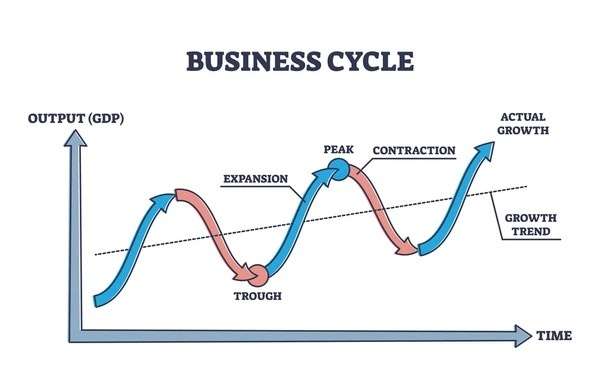The business cycle refers to the recurring pattern of expansion and contraction in economic activity that occurs in a market economy over time. It is characterized by fluctuations in key economic indicators such as gross domestic product (GDP), employment levels, investment spending, and consumer confidence. Understanding the business cycle is essential for businesses, policymakers, and investors to anticipate economic trends and make informed decisions.
Table of Contents
Phases of the Business Cycle
The business cycle typically consists of four main phases:
- Expansion (Boom):
- Definition: The economy experiences growth in economic activity, characterized by rising GDP, increased production, higher employment levels, and consumer spending.
- Key Indicators: Rising industrial production, increasing consumer confidence, expanding credit availability, and rising stock market indices.
- Example: During an expansion phase, businesses may experience increased demand for their products or services, leading to higher sales and profits. This phase is often accompanied by optimism and increased investment in new ventures.
- Peak:
- Definition: The peak marks the highest point of economic activity within the cycle. It represents the culmination of the expansion phase.
- Key Indicators: GDP growth reaches its highest point, and indicators like capacity utilization may peak. Employment levels are typically high, and inflation pressures may start to build.
- Example: At the peak, businesses may face capacity constraints as demand approaches maximum levels. Inflationary pressures may lead to higher costs of production and potential wage pressures.
- Contraction (Recession):
- Definition: The economy begins to slow down, leading to a decline in economic activity. A recession is characterized by falling GDP, declining consumer spending, rising unemployment, and reduced business investment.
- Key Indicators: Decreasing industrial production, rising unemployment rates, declining consumer confidence, and decreasing retail sales.
- Example: During a recession, businesses may experience reduced demand for their products or services, leading to lower revenues and profits. Cost-cutting measures such as layoffs and reduced capital expenditures are common during this phase.
- Trough:
- Definition: The trough represents the lowest point of the business cycle, marking the end of the contraction phase and the beginning of recovery.
- Key Indicators: GDP growth stabilizes or starts to turn positive. Unemployment rates may peak, and consumer confidence begins to improve.
- Example: Businesses may start to see signs of stabilization and gradual improvement in demand. Policy interventions and stimulus measures often aim to support economic recovery during this phase.
Importance of Understanding the Business Cycle
- Forecasting: Helps businesses and policymakers anticipate economic trends and adjust strategies accordingly.
- Risk Management: Allows businesses to prepare for downturns and manage risks associated with economic fluctuations.
- Investment Decisions: Influences investment decisions such as expansion plans, capital expenditures, and hiring strategies based on the current phase of the cycle.
- Policy Formulation: Guides policymakers in implementing appropriate fiscal and monetary policies to stabilize the economy during downturns or prevent overheating during expansions.
Example of the Business Cycle
During an expansion phase, a manufacturing company experiences increased orders for its products due to strong consumer demand. As the economy reaches a peak, the company operates at full capacity, leading to higher production costs and potential supply chain challenges. In a contraction phase, demand for the company’s products declines, resulting in reduced production levels and adjustments in workforce size to manage costs. During the subsequent recovery phase, the company gradually increases production as economic conditions improve and consumer confidence returns.
Reference
The business cycle is a well-documented economic concept studied by economists and analysts worldwide to understand the dynamics of market economies.
Conclusion
In conclusion, the business cycle is a natural pattern of economic fluctuations consisting of phases of expansion, peak, contraction, and trough. Each phase impacts businesses differently, influencing decisions on production, investment, employment, and financial planning. Understanding the business cycle helps businesses navigate economic uncertainties and capitalize on opportunities during periods of growth while preparing for challenges during downturns. By monitoring key economic indicators and recognizing the signs of each phase, businesses can adapt their strategies to thrive in a dynamic economic environment.





